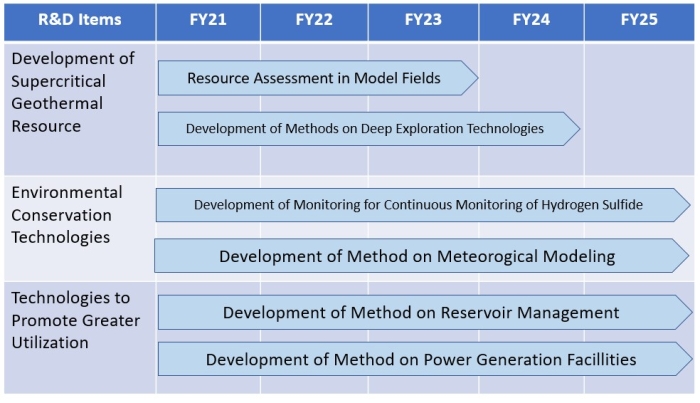R&D for Innovative Technologies Applied to Geothermal Exploration and Exploitation
Project overview
In the "Fifth Strategic Energy Plan," geothermal power is positioned as an energy source that can play a role as a base-load power source with low generation costs and stable power generation. In addition, the "Long-term Energy Demand and Supply Outlook" calls for the introduction and expansion of geothermal power generation in 2030, which is expected to amount to approximately 1.55 million kW or 11.3 billion kWh of electricity generated at most.
Furthermore, in "Green Growth Strategy through Achieving Carbon Neutrality in 2050," supercritical geothermal power generation is expected to enlarge the scale of power generation facilities to about 100,000 kW and reduce power generation costs. This is considered an important geothermal power generation technology for achieving carbon neutrality by 2050, and it is expected to be introduced in greater numbers after 2040.
This project ultimately aims to promote the greater introduction of geothermal power generation, including the development of geothermal resources found in Japanese national parks, and achieves a maximum geothermal power generation capacity of 1.55 million kW for the realization of the energy mix in 2030. NEDO will conduct research and development related to geothermal resource assessment for supercritical geothermal resources, which are attracting attention as a next-generation innovation technologies and promote the further expansion of geothermal power generation introduction.
(1) Development of Supercritical Geothermal Resource Technologies
(2) Development of Environmental Conservation Technologies
(3) Development of Technologies to Promote Greater Utilization of Geothermal Power Generation
Research and Development
(1) Development of Supercritical Geothermal Resource Technologies
[1] NEDO estimates the presence of geothermal resources at supercritical water areas 5 km below the ground (or equivalent) and evaluates the amount of such resources by conducting ground surface surveys (geological, geochemical, geophysical, etc.) and geothermal structure survey drilling. At the same time, NEDO selects materials and equipment that can be drilled in the anticipated underground environment and proposes investigation wells and blowout test specifications that are feasible to achieve the goals with respect to safety and the environment. In addition, NEDO will implement a re-evaluation of economic feasibility.
[2] NEDO develops (1) a seismic monitoring method that is expected to be used for geothermal resource exploration and (2) measurement equipment that can withstand high-temperature environments.
(2) Development of Environmental Conservation Technologies
NEDO improves technologies for environmental conservation measures by means of (1) the development of methods for various types of investigation, prediction, and evaluation in environmental assessment (e.g., air quality and such), specifically, the development of equipment for continuous monitoring of hydrogen sulfide, which contributes to significantly improving the quality and quantity of data and the accuracy of prediction and assessment, and (2) the development of a weather modeling method to replace weather observations and significantly shorten the survey period.
(3) Development of Technologies to Promote Greater Utilization of Geothermal Power Generation
NEDO develops methods to efficiently and optimally manage geothermal power generation facilities and geothermal reservoirs, respectively.
NEDO cultivates technologies to monitor migration pathways of recharge water, reservoir temperature, and pressure effects in conjunction with vibrations (earthquakes) in real-time and spatiotemporally. NEDO implements the development of elemental technologies such as (1) multi-sensor and long-life optical fiber for high temperature, (2) evaluation technologies (simulation technologies) for recharge water flow paths and flow conditions by utilizing monitoring results, and (3) measurement technologies to understand reservoir characteristics, in addition to other measures.
Project Manager
KONDO Yosuke Chief Officer
Outcome Target
Around 2030, it is expected that the utilization rate on average and the electricity generation cost at geothermal power plants will be improved by 20% pt and reduced respectively from the current level, and approximately 1.55 GW of generation capacity amount and 11 TWh of electricity generation amount will be achieved at most. The CO2 emissions amount reduced as a result of this is approximately 6.3 million tons-CO2/year. Furthermore, around 2040-2050, NEDO will aim to disseminate geothermal power plants (five plants with 100 MW-class) that utilize supercritical geothermal resources. The estimated resource amount is 11 GW, which will reduce CO2 emissions by approximately 45 million tons-CO2/year.
Output Target
This project ultimately aims to promote the greater introduction of geothermal power generation, including the development of geothermal resources found in Japanese national parks, and achieves a maximum geothermal power generation capacity of 1.55 million kW for the realization of energy mix in 2030. NEDO will conduct research and development related to geothermal resource assessment for supercritical geothermal resources, which are attracting attention as a next-generation innovation technologies and promote the further expansion of geothermal power generation introduction.
Project Process Control Chart
Basic information
| Technical field |
|
|---|---|
| Project code | P21001 |
| Department in charge |
|
Last Updated : July 9, 2024

